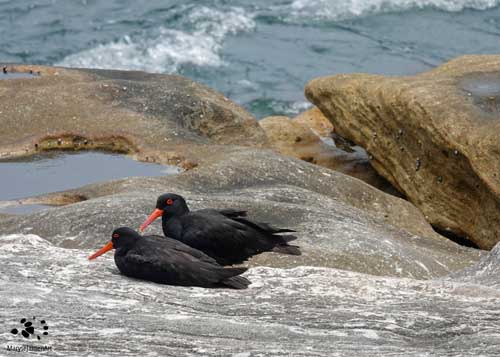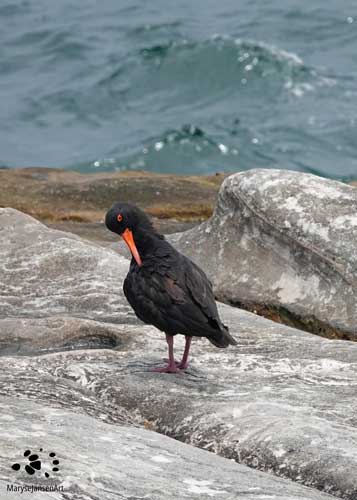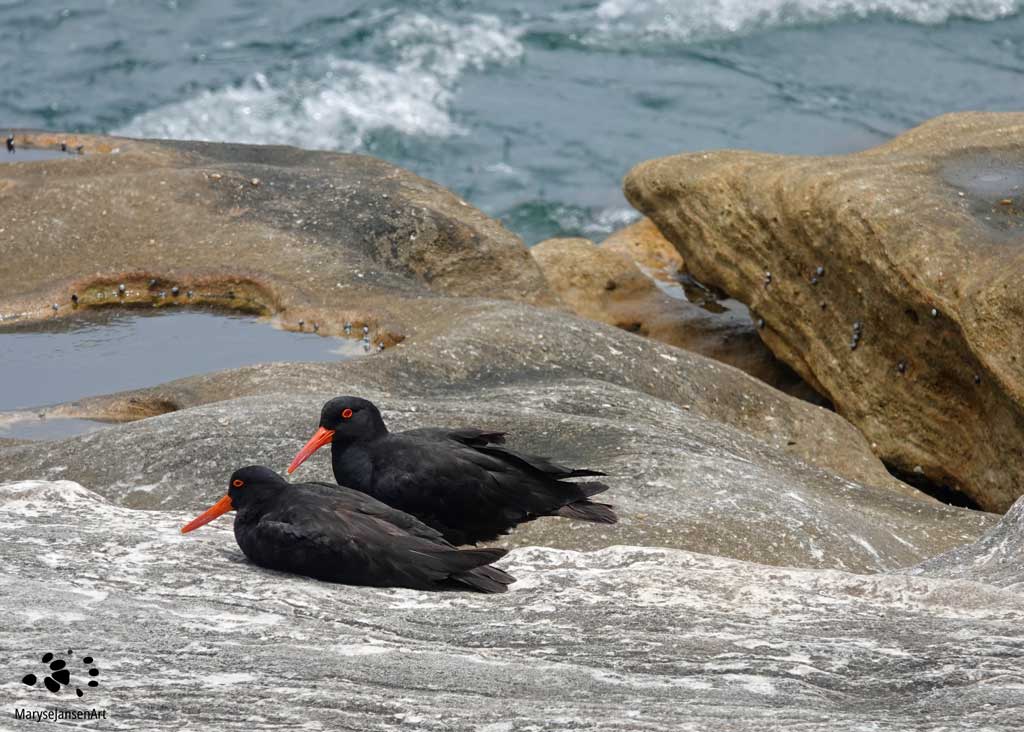Bird Photography with marysejansenart
The Importance and the Potential of Urban Nature

Table of Contents
A Surprise in Sydney!
Wandering through the concrete jungle of the Sydney CBD, I notice very little greenery. However. there are some small pockets of nature that have been conserved. They are scattered around the Sydney Harbour, and together they make up the Sydney Harbour National Park. As I am exploring one of these pockets of bushland in the big city, I am pleasantly surprised to suddenly lay eyes on a pair of Sooty Oystercatchers!
It is actually my first ever sighting of this species! That is not so strange as they are very sparsely distributed along Australia’s shorelines. They are widespread, but definitely uncommon. Oystercatchers are quite shy of people so I am definitely surprised to encounter them here in Sydney! And all in all this moment is extra special because here in New South Wales, these birds are listed as vulnerable!
Sooty Oystercatcher has clever feeding techniques
The Sooty Oystercatcher is a heavy set wading bird, similar to the Australian Pied Oystercatcher. While the Pied Oystercatcher has a black and white plumage, the Sooty Oystercatcher is all black. Both species sport the characteristic long, bright orange-red bill, eye-ring and eyes; as well as the coral-pink coloured legs.
Sooty Oystercatchers’ favourite foods are marine creatures such as mulloscs, crabs and other crustaceans as well as small fish, sea urchins and marine worms. (Check out some of my posts about Marine Life!)
The birds have a great variety of techniques to get to their prey, which is not always easy. Their long, strong bill helps them here. The birds can find prey on rocks or in rock pools and can also be seen probing their bill in the sand to feel where prey is hiding. Once caught, they can use their bill to prise, stab, lever or hammer their prey. Rocks serve a purpose to hold prey in crevices while the birds hammer on their food with their bill until the hard shells crack open and they can devour the insides.
Always close to the shoreline
Their diet always keeps them close to the shoreline, they will never be more then 50m away from the water! Usually, you will see these birds in pairs, which is exactly what I see today! These pairs form a monogamous bond. Younger birds and non-breeding birds sometimes seek each others company in small flocks of 6-8 birds.
When the tide is high, like in this moment, the birds cease their feeding activity and roost on the rocks or the back end of the beach. I watch them while they are seated on the rocks. Then they stand up for a stretch, revealing those pinkish legs. They also spend some time preening and eventually take the characteristic resting position where they stand on one leg.

Sooty Oystercatcher Breeding Habits
In breeding season, the birds create a scrape in the ground, which they may line with coral fragments, pebbles, shells and seaweed to form a nest. They can also build a mound of these lining materials as a nest when they are nesting on the rocks. You can imagine that Sooty Oystercatcher eggs and chicks are quite vulnerable to predators, as the nest is on the ground and often in an open space. So the parents will aggressively defend their nesting territory, by flying up and calling loudly.
The female generally lays 2 eggs and both parents incubate the eggs, while changing over frequently. It takes just up to a month for the chicks to hatch. Both parents feed the chicks which are soon able to begin to follow their parents’ foraging activities. They watch them intently while they are feeding but are also very alert to take cover when the adult birds indicate danger. It takes 3-6 months after hatching before the youngsters become independent.
Finding a place in urban nature
A pair of Sooty Oystercatchers needs a fairly large territory., they prefer at least 50m between nests, usually more. We’re at the far end of breeding season which runs from August to January, and I can’t imagine this would be their breeding site, considering the levels of human disturbance on land and in the water. But who knows? At least they have found a place to hang out here and feed in the area of a metropolitan city. It is quite amazing and just goes to show how important every bit of urban nature can be!
Urbanization has taken away a lot of habitat, but there are also a lot of opportunities to share these spaces with wildlife, if you are willing to be creative! Conserving these pockets of nature that are still left as a National Park is great and super important. And maybe you can also think of something you can do yourself to make your neighbourhood or backyard more wildlife friendly!
Read more about the benefits of doing that for the wildlife and yourself in my post about Biodiversity.
Come with me on this urban nature walk in Sydney Harbour National Park and see if you can spot the Sooty Oystercatchers in the latest episode of ‘Come for a walk in the Australian Bush’:
If you are interested in purchasing ‘Sooty Oystercatcher Pair’ or would like to see what the image looks like on the various products, please head to my shop.


